|
What is obscene? That is a question with almost as many answers as there are people. If we are to accept Definition 1 in Webster's Dictionary—"disgusting to the senses"—then an unflushed toilet or a sink full of long-unwashed dishes is obscene. In using the word, however, most people have in mind Definitions 2A and 2B: "Deeply offensive to morality or decency, esp. designed to incite to lust or depravity," or "containing or being language not acceptable in polite usage."
Even so, Definitions 2A and 2B don't narrow things very much. Different people are offended by different things, and have different thresholds as to how much suggestive material they are willing to tolerate. If we are to adhere to the strict letter of Definition 2B, then the new film The Muppets, with Fozzie Bear trying on "fart shoes" to get a laugh, is obscene. (Personally, though I wasn't particularly offended, I would rather not have heard the word "fart" from the mouth of Fozzie Bear. And I would rather not have had my eight-year-old niece and six-year-old nephew hear him say it. Thanks, Jason Segel.)
Some commentators use the first half of Definition 2A to turn the tables on the censorious, such as the 1970s radio ads for the film Lenny: "Lenny Bruce died at forty. That's obscene." Others are fond of Definition 2C, "so excessive as to be offensive." The example used by Webster's—"an obscene amount of money"—has a great deal of pertinence in these Occupy Wall Street days.
But what do I find obscene? I was having trouble coming up with a coherent definition, until a few weeks ago when Turner Classic Movies—which occasionally airs old industrial films in the very early hours of Saturday morning, as an exercise in high camp—broadcast a short "educational" film called Perversion for Profit.
Undoubtedly, Perversion for Profit is more publicly available now than when it was first made in 1965. 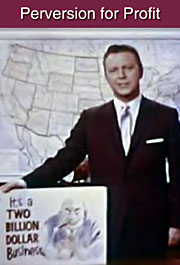 It can be downloaded free from several Internet sources, and is readily accessible on YouTube. Produced by Citizens for Decent Literature (later Citizens for Decency through Law), a group founded by financier Charles Keating, Perversion for Profit has only one performer—"renowned news reporter" George Putnam (actually a TV news anchorman from Los Angeles). Standing in front of a map of the United States, the square-jawed Putnam wastes no time in intoning the core message of the film: "A floodtide of filth is engulfing our country in the form of newsstand obscenity, and is threatening to pervert an entire generation of our American children." It can be downloaded free from several Internet sources, and is readily accessible on YouTube. Produced by Citizens for Decent Literature (later Citizens for Decency through Law), a group founded by financier Charles Keating, Perversion for Profit has only one performer—"renowned news reporter" George Putnam (actually a TV news anchorman from Los Angeles). Standing in front of a map of the United States, the square-jawed Putnam wastes no time in intoning the core message of the film: "A floodtide of filth is engulfing our country in the form of newsstand obscenity, and is threatening to pervert an entire generation of our American children."
Quoting unsubstantiated figures ("75 to 90 percent" of all pornography ends up in the hands of children, he claims at one point) and citing "Dr. Sorokin, the renowned Harvard sociologist" (Pitirim Sorokin actually did found the sociology department at Harvard), Putnam solemnly warns viewers of the pernicious nature of pornography, which, he says, can irredeemably corrupt children who see it even once. Citing ancient Greece and Rome as cautionary examples, Putnam says, "This moral decay weakens our resistance to the onslaught of the Communist masters of deceit."
For its first several minutes, Perversion for Profit plays as a dull, pompous, standard-issue alarmist screed typical of the Cold War era. The mannequin-stiff Putnam—who, at least according to Wikipedia, served as a model for Ted Baxter on The Mary Tyler Moore Show—is just the man to lull '60s-era PTA members into a drowsy sense of security that they, at least, can keep their children away from such filth.
But then Putnam utters the fatal words: "The examples which we are about to show you."
For the rest of the film, the screen is flooded with black-and-white photographs of every kind of porn—Playboy-style nudes, S&M graphics, gay and lesbian scenes. 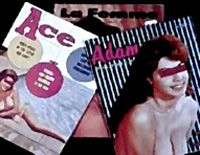 Although Putnam reserves his greatest scorn for a Santorum-like litany of "homosexuals, lesbians, sadists, masochists," there isn't a photo for which he doesn't have a pithy comment. "Very few blind people join the nudist colonies," he opines at one point. "And again, the breast fetish," he says at another, as a pair of size-38 breasts obscured only with small rectangles at the nipples fills the screen. Although Putnam reserves his greatest scorn for a Santorum-like litany of "homosexuals, lesbians, sadists, masochists," there isn't a photo for which he doesn't have a pithy comment. "Very few blind people join the nudist colonies," he opines at one point. "And again, the breast fetish," he says at another, as a pair of size-38 breasts obscured only with small rectangles at the nipples fills the screen.
Perversion for Profit is often represented as a masterpiece of unintentional hilarity, and it does have its share of laugh lines, as the above quotes demonstrate. 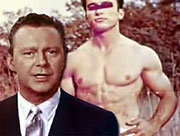 Those laughs, however, turn bitter as the film progresses, and cease altogether when Putnam turns his attention first to gays, then to young teenagers used in pornography. Those laughs, however, turn bitter as the film progresses, and cease altogether when Putnam turns his attention first to gays, then to young teenagers used in pornography.
Perversion for Profit's attitude toward gays is summed up when Putnam quotes "a slogan that shows the evil of the breed: 'Today's conquests,' they say, 'are tomorrow's competition.'" He says this as he shows a close-up photo of a pleasant-looking, crew-cut boy of maybe fourteen or fifteen. "A smile that could light the world," he says, and then we see a long shot of the same boy naked, except for a narrow rectangle across his buttocks.
"Look at this poor young lad," Putnam says. "Think of those that might follow in his perfidious footsteps."
But how can he be a "poor young lad" if he is also "perfidious?"
I have no way of describing the feelings of depression and despair that fill me when I think about Perversion for Profit, and its poisonous yet all-too-typical combination of sanctimony and prurience. For thirty minutes Perversion for Profit traps us in its airless, ugly little world, like a video game in which you must keep killing monsters until a monster kills you. It slavers over what it condemns; it completes and compounds the objectification of those it pretends to pity. It creates a dreary, either-or world of saints and whores, in which Charles Keating, George Putnam and their compatriots are the sole arbiters. Watching it dredged up unpleasant memories of Jimmy Swaggart, Ted Haggard, and plenty more of their kind.
Perversion for Profit made me do something I would not otherwise have done: order Larry Flynt: The Right to Be Left Alone, a documentary by Joan Brooker-Marks, from Netflix. (The most famous film about Flynt—Milos Forman's The People vs. Larry Flynt, produced by Oliver Stone—is irrelevant to my theme here. It is Flynt according to Stone, with Forman as quarryman.) The court battle between Keating and Flynt is the most famous (or infamous) First Amendment case of the past half-century, but just because I'm glad Flynt won doesn't mean I like or admire him in any way.
Larry Flynt: The Right to Be Left Alone concentrates on its subject's history as a First Amendment crusader, but I tended to pay more attention to aspects of Flynt's history that neither Brooker-Marks nor anyone else can ignore. One defining moment is when Flynt laughs off as a failed attempt at satire the Hustler cover showing a woman's naked legs sticking out of one end of a meat grinder and hamburger coming out the other. I couldn't help noticing, at that moment, how much Flynt's voice sounds like a meat grinder.
In the documentary, Flynt is also a fount of pithy quotes. "There 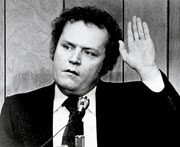 are two types of people who are opposed to pornography—those who don't know what they're talking about, and those who don't know what they're missing," he says. Well, in my own misspent 1970s youth, I saw enough copies of Hustler to find out what I was missing. Even more than the photos, I remember the cartoons, which my buddies at the time thought were hilarious. One was captioned, "Six Fags Over Texas," and showed six skeletons in flamboyant dress strung up on a cottonwood. I won't describe any others, partly because some were so Byzantine as to be almost indescribable (like many of the sex jokes told in a seventh-grade locker room) and partly because they would make some readers throw up. I'll just mention that bestiality and pedophilia were frequent topics, as was—amazingly for such a homophobic publication—sado-masochistic homoeroticism. are two types of people who are opposed to pornography—those who don't know what they're talking about, and those who don't know what they're missing," he says. Well, in my own misspent 1970s youth, I saw enough copies of Hustler to find out what I was missing. Even more than the photos, I remember the cartoons, which my buddies at the time thought were hilarious. One was captioned, "Six Fags Over Texas," and showed six skeletons in flamboyant dress strung up on a cottonwood. I won't describe any others, partly because some were so Byzantine as to be almost indescribable (like many of the sex jokes told in a seventh-grade locker room) and partly because they would make some readers throw up. I'll just mention that bestiality and pedophilia were frequent topics, as was—amazingly for such a homophobic publication—sado-masochistic homoeroticism.
Brooker-Marks includes some anti-Flynt voices in her documentary. Gloria Steinem warns at one point that in honoring Flynt we hand the mantle of the First Amendment to a fetishist. Considering Flynt's life history and the contents of Hustler, I'd say Steinem was being kind in using the word "fetishist."
I haven't even considered the career of Charles Keating (his crusade against porn was an extracurricular activity). 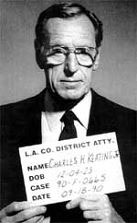 I don't know how much I can say about the Lincoln Savings & Loan trials without getting sued; Keating's original conviction was overturned, and he later pleaded guilty to lesser charges in order to receive a sentence of time served. I do know that neither Charles Keating nor Larry Flynt can by any stretch of the imagination be considered a decent man. I don't know how much I can say about the Lincoln Savings & Loan trials without getting sued; Keating's original conviction was overturned, and he later pleaded guilty to lesser charges in order to receive a sentence of time served. I do know that neither Charles Keating nor Larry Flynt can by any stretch of the imagination be considered a decent man.
And this, at last, is what I find obscene. Adhering to the first part of Definition 2A, I find it obscene that freedom of speech, a liberty I hold dear, has been defined in my lifetime by the public war between two scoundrels. Charles Keating and Larry Flynt are flip sides of the same coin: they both believe that sex is dirty, that people are meat, and that the world is theirs to despoil. To realize that they are far from unique, and that men like them have held positions of power throughout recorded history, is not exactly comforting.
|



